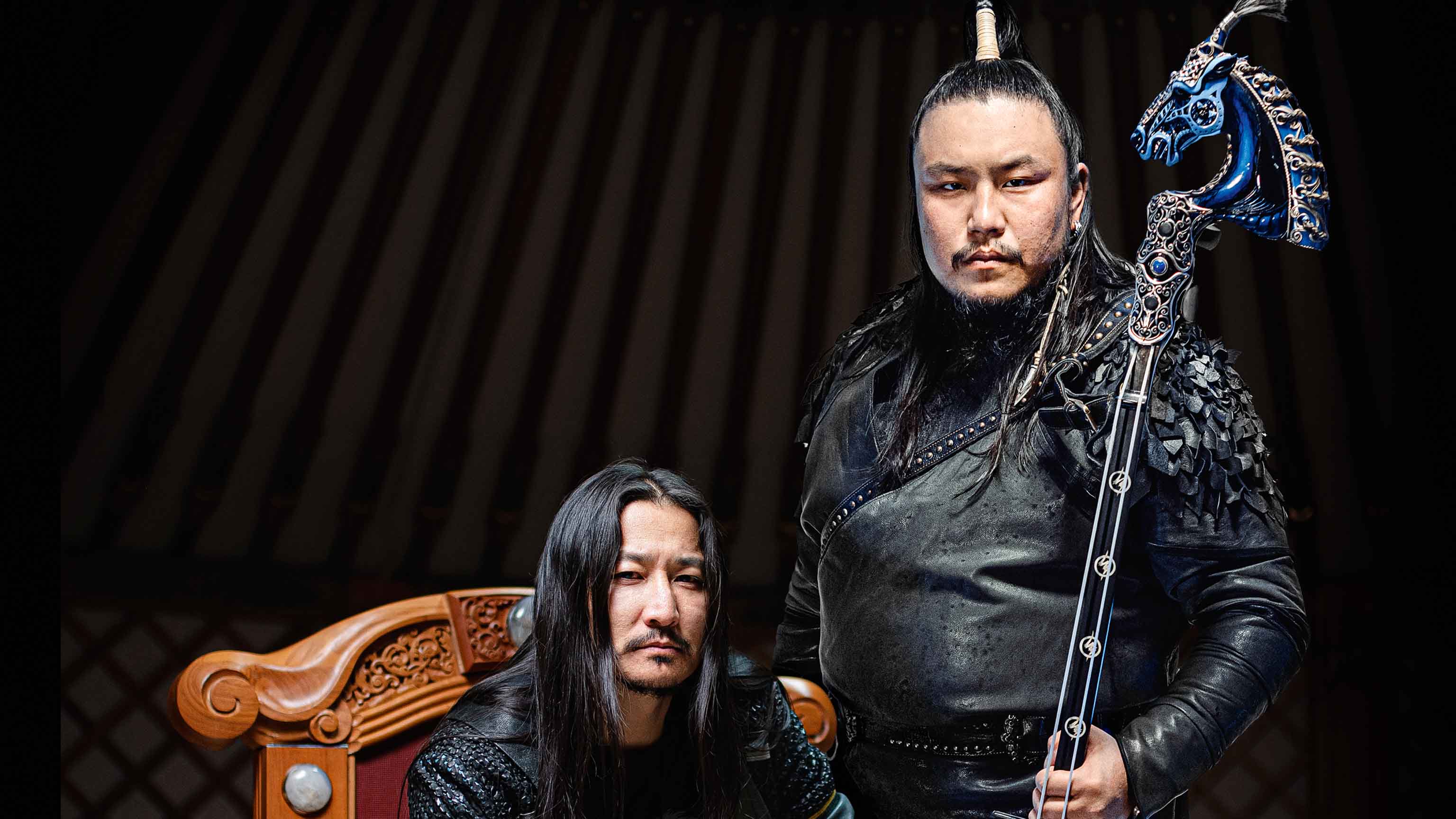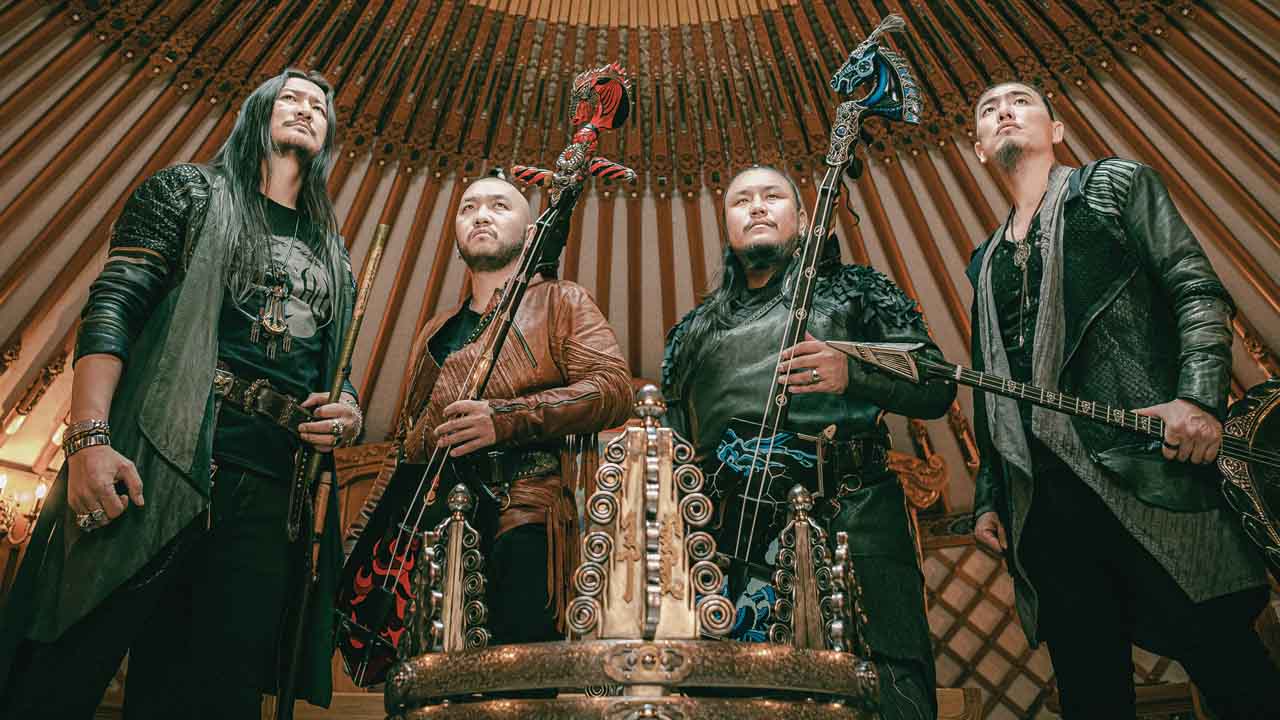“HU! HU! HU!”
It’s Saturday afternoon at Download Festival 2019 and a loud, insistent chant is coming from a corner of Donington Park. No, not “SLAAAAAAAYYYYYYYYYERRRRR!” – Kerry King and co don’t play until tomorrow. It’s the sound of thousands of metalheads crammed into the Dogtooth tent, and they’re all here to see The Hu, the Mongolian folk metal phenomenon who are on their first visit to the UK. Before they even get onstage, it’s madness. The crowd is five-deep outside the tent and everyone is punching the air and craning their necks to catch a glimpse of one of metal’s most exciting new bands.
Despite their growing online profile, The Hu were taken aback by the response. “We were concerned: what’s going to happen? How are people going to react to our music?” recalls the band’s sweet but serious frontman, Gala, speaking over a Zoom call today via the band’s interpreter, his brother Tuga. “Even when we played the last song, we could see people walking towards us. We didn’t know that tent was packed beyond [capacity] until we saw the pictures.”
- The most exciting heavy bands of 2021… aren't actually metal
- How Indonesia built the world’s most exciting underground metal scene
- Every Metallica album ranked from worst to best
- Reign in Pain: How Slayer conquered Britain
Blending western metal with traditional Mongolian instruments and the incongruous sound of throat singing, The Hu have coined the term ‘hunnu rock’ to describe their style, meaning ‘human’ – and if they were a curiosity to start with, they sure as hell can’t be dismissed as such now.
“It’s not about being Mongolian,” Temka, the band’s chilled and funny tovshuur (Mongolian guitar) player explained to The Guardian last year. “It’s about being human.”
In the same way Rammstein and Babymetal have transcended the language barrier, The Hu’s songs, which speak of Mongolian culture and history and are sung exclusively in the band’s native tongue, have struck a chord with metal fans on a worldwide scale.
“It amazes us how people connect to our music,” says Jaya, the smiley and energetic multi-instrumentalist who sometimes punctuates his sentences with enthusiastic chants of, “Hu! Hu! Hu!”. “We think it’s just the timing. The rock world needed something different, so we came up with something unique. Music is a universal language, you still get connected. You can pick up the chant along the way and that’s exactly what happened with us.”
The numbers are eye watering. At the time of writing, since being uploaded in autumn 2018, the video for their first single, Yuve Yuve Yu, has had more than 63 million views on YouTube. Its follow-up, Wolf Totem, has been viewed more than 44 million times. To put that into perspective, it dwarfs anything uploaded onto the streaming platform by Architects, Parkway Drive or even Slayer. Even a video series of The Hu cooking together, craftily named Hu’s In The Kitchen? - which we reported on in Metal Hammer 338 – has been watched hundreds of thousands of times.
In 2019, the band signed a deal with Better Noise, the home of Papa Roach and Five Finger Death Punch. They were preparing to head off on a massive North American tour and unleash their debut, The Gereg, on the world right in the middle of it all. The hype soared as they dropped some reworked tracks with their labelmates: an adaption of Yuve Yuve Yu with Danny Case, the singer from nu metal band From Ashes To New, and a new version of Wolf Totem featuring a fired-up verse from Papa Roach’s Jacoby Shaddix. In 2020 they released a rerecording of Song Of Women with Halestorm’s Lzzy Hale, followed by a cover of Metallica’s Sad But True, complete with an epic fantasy video.

And it isn’t just the rock world that has sat up and taken notice. A videogame development studio, Respawn Entertainment, asked the band to contribute a song to the soundtrack of 2019’s Star Wars Jedi: Fallen Order. With Respawn and Lucasfilm, the band wrote the track Sugaan Essena, initially in Mongolian before translating it into a fictional, alien language specifically for the game. It seems their reach is endless.
“We feel love and support everywhere we go now,” says Jaya. “Our first official gig outside Mongolia was at Rock Im Park Festival in Germany and it was the first slot at noon. Nobody comes to the stage at noon, so we didn’t know how many people, maybe five, maybe 10 [would show up], but we were eager to play. When we got up, it was full of people. They were waiting for us chanting, ‘Hu! Hu! Hu’. They’d never seen our live concert before, but it was as if they were waiting for this super rock band that’s been around for many years. What a way to start our journey…”
Unsurprisingly, given the speed of their ascent, life has changed for the band. In their hometown of Ulaanbaatar, Mongolia’s buzzing capital, they are frequently stopped on the street and asked for selfies. “Back in the day I could walk in the high street and nobody would notice, but now people know we’re The Hu,” smiles Gala. “We always treat people nicely, we are always open to taking pictures.” And wherever the band go on tour, they’re greeted with sold-out venues and devoted crowds, all bellowing their moniker. “When we were doing our first North America tour there was a group of people following us to every gig,” says Temka. “Some of them had never travelled their own country. One of the girls we talked to said she had never left her own city but was doing a road trip.”
It might seem like they appeared from nowhere, but The Hu have been doing this for a long time. Gala and Temka have been friends since they met at school aged 11, and Gala has been playing in local bands with Jaya and Enkush, The Hu’s quiet, thoughtful lead Morin Khuur (horsehead fiddle) player, for the last 10 years. All four men studied music at the Mongolian State Music And Dance Conservatory in Ulaanbaatar, where they learned the noble art of throat singing and where Jaya has also taught. “We’re on a mission. We’ve been working for it for decades,” he says. “It’s not an accident we’ve got here. We’ve been learning and mastering our skills at least 20 years each. We started at such young ages, professional schooling; a lot of learning and crafting our skills every day brought us here.”
Under the rule of the socialist Mongolian People’s Revolutionary Party, all western music was banned in Mongolia until 1992, although Jaya reveals that even back then bands were nudging at the boundaries. “There were bands that paved this world for us. Even though they were not legally allowed to play rock music, they would put some rock elements into their songs… subtle elements, enough to be legal!”
Having been born in the 90s, The Hu grew up listening to bands such as Metallica, Rammstein, System Of A Down and Queen. By the noughties, plenty of rock bands including Haranga, Altan Urag and Tengger Cavalry had sprung up in Mongolia, boasting a mild iteration of The Hu’s culture-crossing sonic blend, but none managed to achieve the same international success.
It would take a visionary to take it to the next level. Like Babymetal, whose fusion of brutal metal and J-pop was pioneered by Japanese producer Kobametal, the concept of merging western rock with traditional Mongolian instrumentation on a cinematic level was the idea of the band’s producer and songwriter, B. ‘Dashka’ Dashdondog, who knew Gala from Ulaanbaatar’s tight-knit music scene. In 2016, the pair began working together to bring Dashka’s vision to life, but quickly realised they needed more bodies onboard, bringing in Gala’s long-term friends and collaborators to complete the line-up.

“Dashka had this great idea already in his head but creating this music was a process,” explains Gala. “It wasn’t easy to find something nobody had done before. We didn’t even know what we were chasing. Eventually we found the sound we were looking for.”
The result was a combination of East and West, ancient and modern. Tapping into the legends and spiritual stories of the band’s ancestors, many of the songs on the band’s debut, The Gereg, are a call to arms. Wolf Totem tackles the concept of the inner warrior and facing your fears. Shoog Shoog is a call to the Tengri (Mongol Gods) and Shireg Shireg is a battle anthem set to the rhythm of horse hooves.
“The horse head fiddle is a traditional Mongolian instrument that has been played by our ancestors for thousands of years,” explains Gala. “This instrument is connected to the horse and our history as horsemen. It is very important to our music.”
War, horses, freedom – obviously this kind of thing is catnip to metalheads. But there’s far more to these songs, which are intrinsically tied to Mongolia’s vast landscapes and are accompanied by expensive, Lord Of The Rings-esque music videos that show its breathtaking scenery – mountains, deserts and great plains – in all its glory. “Throat singing is a style our ancestors used to communicate with nature by trying to make similar sounds as water and wind,” explains Gala. “Protecting, co-existing with and respecting nature is very important and we’d like to share this culture with the world.”
That determination to promote the beauty of their home country has not gone unnoticed. Last year, the band were awarded the Chinggis Khaan Order, by Mongolian President Khaltmaagiin Battulga. As the country’s highest state distinction, it’s usually reserved for high-profile politicians, and occasionally poets, singers and sportsmen who champion Mongolian culture. But until now, never bands. “It’s a complete honour for us,” says Gala. “This is such an important award. Before us, only 11 people in the country have received it and we were the first group of people. In the past it was only presented to individuals. [Now people will see] you don’t have to be an individual to receive it.”
The magnitude of these achievements is not lost on The Hu, and neither is the burden of heavy responsibility that comes as part of the package. According to the band, metal is still a small, underground movement, albeit it one that’s ever-expanding. And aware that they are now the leaders of that scene, they are keen to ensure that others can follow in their wake. “It’s not easy to be the ice-breaker,” admits Jaya. “Following in someone’s footsteps is easier most of the time. We work hard and we are proud to be the one to pave the way for other bands who will come after us. The satisfying thing is that other young people are coming up after us in Mongolia. We’re inspiring these people. If you work hard, anything is possible. If you really love it and picture it, and work for it, things will happen. This is the most satisfying thing for us.”
2020 should have been a massive year for them, including appearances at all Lollapalooza Festivals in America and Latin America, plus a set at Coachella, but COVID-19 put all that on ice. Now, though, the band are plotting their 2021. Not only are they hoping to revisit those plans, they have already announced European festival dates for the summer, not to mention they’ll be releasing more of the songs that were recorded for Star Wars Jedi: Fallen Order. Then, of course, there’s the question of the follow-up to The Gereg…
“We’re working on our second album now; we’re spending so much time at the studio,” says Gala with a big grin, revealing that the band are planning to release their second record in mid-2021, although they’re keeping tight-lipped about what it might entail or if any guests will feature on it. “Most of the songs are shaping up real good, it’s going to sound just like The Hu. That’s [a sound] we’ve found, and we’re going to keep doing what we’re doing. Yes there will be different ideas, we’re always looking for something new, but we believe our style is unique. We called it ‘hunnu rock’ because there is no box we can put it into.”
Published in Metal Hammer #344

